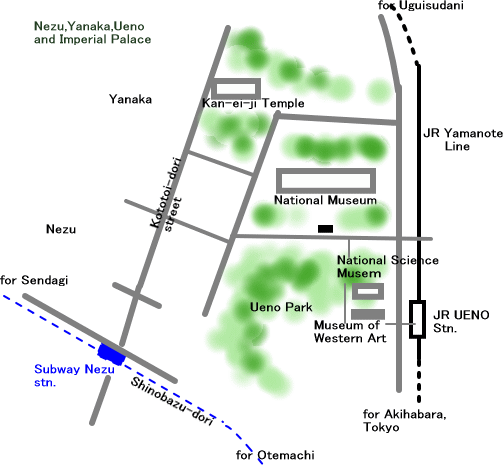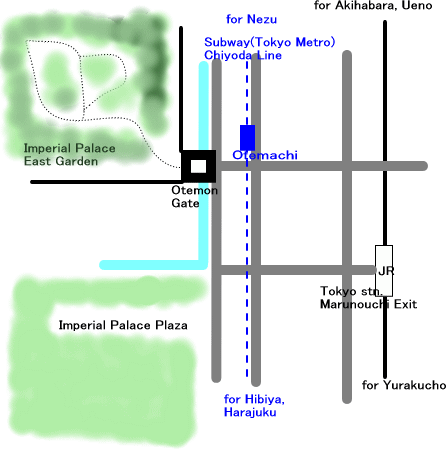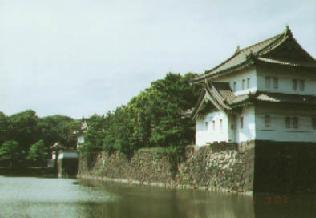|
For
Early Birds
<Tsukiji Central Wholesale
Market>
access: 3 minutes7 walk fromTsukiji station, (subway)
Eidan Hibiya line
or Tsukiji-shijo station, (subway)Toei Oedo
line
Tsukiji Wholesale Market is one of the largest of its
kind in Japan, handling fish, meat, vegetables, fruits, and flowers. It has its
origin at the beginning of the Edo period (1603). The busiest time here is early
in the morning; at 5 o'clock the Market begins to hum. Auction of fish begins
at 5:30 a.m. vegetables at 7:00 a.m. and flowers at 7:30 a.m. The Market is
closed at about 11:00 a.m. Around the market are many shops run by intermediate
wholesalers. There are also restaurants where you can get breakfast at a
reasonable price. If you need a little exercise to aid your digestion, it may
be a good idea to explore alleys around the Market. There are places of
interest within walking distance such as Tsukiji Honganji Temple, Seiroka Tower
and Hamarikyu Garden.
Tsukiji Honganji Temple Open Hours: 10:00 a,m.-4:00 p.m. Admission:
free.
Hamarikyu Garden Open Hours: 9:00 a.m.-5:00 p.m.
Admission: \300
For further information click here.
<Sumo> -sport or ritual ? What about
visiting a sumo stable?
Access: Ryogoku station, (subway) Toei Oedo Line,
or
Ryogoku station, (Japan Railways)
Sobu line
By the river Sumida is located the Ryogoku Kokugikan gymnasium,
where three of the six annual grand sumo (Japanese wrestling) tournaments
are held. Sumo, a kind of wrestling is regarded as Japan's national
sport. It was originally a ritual dedicated to the Shinto god and both
the wrestlers and judges are in a traditional hair style and costume.
There are a number of sumo stables located in and around
this district. Sumo wrestlers live with their masters
and train hard every day to prepare for the tournaments.
You will be welcome if you visit one of the stables to view the practice. No
admission is required but reservation is necessary because the wrestlers are
often on tour. Their practice is usually from 7:00 a.m. to 10:00 a.m. approximately
for three hours. The Edo Tokyo Museum is also near Ryogoku station.
* For further information about sumo, contact the Japan Sumo
Association.
* Sumo museum at Kokugikan gym. is open to the public when
there is no tournament held there.
Access: One minute's walk from Ryogoku
station
Open: 10:00 a.m. - 4:30 p.m. Monday through Friday
Closed on weekends, National holidays, before and after New
Year's Day
Museums
and Theaters
<Kabukiza Theater> - a bit
of Japanese tradition
access: Right in front of Higashi-Ginza station,
(subway)Toei Asakusa line, or Ginza line
Kabuki is a traditional theatrical art which is a combination of
play, music and dancing. It has its origin in the Kabuki Odori dance performed
by priestesses at the end of the 15th century and was completed as an artform in
the middle of the Edo period.
At Kabukiza theater, tickets for one act,
called "Makumi"tickets are available. No reservation is needed but the seating
capacity is 90 and the seats are on a first-come first-served basis. (150
tickets are for sale). The seats are on the 4th floor which seems a little far
from the stage but there you can still fully enjoy the play. The ticket office
is on the left side of the front entrance as you face the theater. The price
varies depending on the length of of the act. For more detail click here.
Museums
<The Tokyo National
Museum> - Japanese history and culture
access: (JR) 10 minutes from Ueno station, Yamanote or
Keihin-tohoku line
(Subway) 15 minutes from Ueno station, Ginza or
Hibiya line
(Keisei Railways) 15 minutes from Ueno station
The Tokyo
National Museum is one of the oldest and largest museums, where
archaeological relics, sculptures, paintings, and other works of art are
exhibited.
Open Hours: 9:30 a.m. - 5:00 p.m.
Closed on Mondays - exception: the museum is open when a national
holiday falls on Monday, and closed on the following day.
Admission: adults \420
university students \130
The site of the museum was part of
the Kaneiji Temple in the Edo period. This district, Ueno, is in the
northeastern quarter of Edo or Tokyo, which was believed to be an unlucky
direction; and therefore the temple was built to protect the shogun and his
family from evil. Today three museums of art, a museum of science, a concert
hall, and a zoological park are located here.
<The Edo Tokyo Museum>
- learning Japanese History
access: (Subway) Ryogoku station, Toei Oedo
Line
(JR) Ryogoku station, Sobu Line
* The museum is right next to the
sumo gymnasium
Open: 9:30 a.m.- 5:30 p.m.
Closed on Mondays (or the following day when Monday is a
holiday)
December 28 - January 4
Admission: Adults \600
College students \480
High school students and adults over 65
\300
Junior high school (outside Tokyo) students
\300
Junior high school (in Tokyo) students
Free
Elementary school students
Free
The museum building, designed after a storehouse of the
Edo period, is an outstanding ferro-concrete structure only a step from Ryogoku
station.
For more information, click here.
|
Special Days at Shrines -
En-nichi and Flea
Market
<Tomioka Hachiman Shrine>
En-nichi (festive days): the 1st, 15th and 28th every
month
Antique Market: the 1st (Western antiques) and 2nd
(Oriental antiques) Sundays
Click here
access: (Subway) 3 minutes from Monzen-nakacho
station, Toei Oedo or Eidan Tozai line.
* Fukagawa Fudo Do (Buddhist temple) is near
here.
<Togo Shrine>
Antique Flea Market: on the 1st Sunday every month click here
(In December, on the 1st and 4th
Sundays only)
access: (JR) 10 min. from Harajuku station, Yamanote
line
* Meiji Shrine and Omote-Sando street are within walking distance
from Togo Shrine.
<Hanazono Shrine>
Antique Flea
Market: every Sunday
access: (JR) 10 minutes from Shinjuku station
<Nogi Shrine>
Antique Flea Market:
on the 2nd Sunday except November
access: (Subway) 1 minute from Nogizaka station, Chiyoda
Line
|
|
Half-Day Walk in Tokyo
Have you read Gulliver's
Travels written by Jonathan Swift? If you have, then, do you remember the
main character Gulliver visited Japan, which is the only really existing country
described in the story? All the other countries he visited, Lilliput,
Brobdingnag, Laputa, Balnibarbi, Glubbdubdrib, Laputa, Luggnagg and Houyhnhnms
are fictitious. Probably, for Swift Japan was so remote that it was among the
imaginary places. After having disembarked at a port not very far from the city
of Edo, Gulliver was led to the Edo castle and had an audience with the emperor
(shogun). A fictional character of the West visited a real city of the East in
the year 1709, a little over 300 years ago. Roads in the city may have been
dusty due to volcanic ashes from Mt. Fuji which had erupted in 1707.
|
Course: Tokyo station - (walk) - The
Imperial Palace East Garden (former Edo Castle) - (subway) - Nezu - (walk) -
Yanaka (Temple district) - Ueno


It is wonderful to enjoy wild plants right in
the center of the metropolis. You will find a small but typical example of
deciduous broad-leaved forest there. At this time of year blossoms of Japanese
apricot are in bloom and more flowers are coming out very
soon.
After visiting the castle site, you take the
subway to the temple district, where you will enjoy walking through alleys to
look for the remnants of old Tokyo. How many temples can you find? This part of
Tokyo survived both the Great Kando Earthquake (1923) and air raids during the
2nd World War (1941-1945) though much of the city was nearly leveled in these
two devastating incidents. The lanes are very narrow; still cars are driving
through just like many other back streets in Tokyo. Your walk concludes at
Ueno, where several museums and a zoological park are located.
*The East Garden of the Imperial Palace
Admission: free
Closed: Monday and Friday
Back to the top of the page
|


